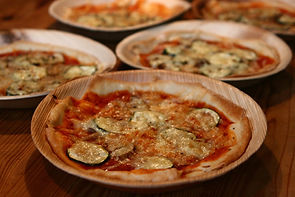
LEEF PLASTIC BEHIND
ISS NACHHALTIG VON
PALMBLATT STATT PLASTIK




KLICK!

Probier's nochmal
WILLST DU PLASTIKABFALL VERMEIDEN?
Bist du sicher?
Komm schon...
Spaß beiseite, klick JA
Hoffnungsloser Fall!

WARUM PALMBLATT?
HÖCHSTE FUNKTIONALITÄT ALS NACHHALTIGSTE ALTERNATIVE
WUNDERSCHÖNER ÖKO
Öko und ästhetisch?
Klingt Paradox, aber Palmblatt macht's möglich! Essen von einem natürlich gewachsenen Palmblatt ist nicht nur schöner als von Bagasse oder Papier, sondern auch besser für unsere Umwelt.
NATÜRLICHER TYP
Biologisch abbaubar,
industriell kompostierbar?
Das reicht uns nicht, unsere Teller werden unbehandelt aus einem naturbelassenen Blatt geformt. So sind sie gartenkompostierbar und können als einzige Plastikalternative unbedenklich entsorgt werden.
ALLESKÖNNER
Verbrannte Finger,
labbrige Teller?
Nicht mit uns!
Stabilität, Hitze & Kältebeständigkeit ermöglichen eine vielseitige Anwendung in Mikrowelle, Ofen, und Kühlschrank, sowie mit allen Speisen, ob fettig, flüssig oder fest, heiß oder kalt .


AUSWAHL UNSERER PRODUKTE
TELLER, SCHALEN, TABLETTS, BESTECK & MEHR
 |  |  |
|---|---|---|
 |  |  |
 |  |  |
 |  |
PALMBLATTTELLER LEBENSZYKLUS
CRADLE-TO-CRADLE

ANGEBOT
ENTSORGUNG
NUTZUNG
HERSTELLUNG
HERKUNFT
Bewege deine Maus über die Abschnitte des Lebenszyklus um mehr zu erfahren
Angebot
-
Unsere Produkte erfüllen höchste Standards für Lebensmittelsicherheit
-
Alle Teller sind in kompostierbarer Folie verpackt
-
Wir bieten Teller, Schalen, Servierplatten und Tabletts in allen Formen und Größen
-
Unser Holzbesteck ist überzogen mit pflanzlichem Biowachs
Herstellung

-
Natürlich abgefallene Blätter werden gesäubert, getrocknet, gepresst und zugeschnitten
-
Die Produktion erfordert kaum Energie und ist somit sehr ressourceneffizient
-
Unsere Teller werden nicht beschichtet und bleiben naturbelassen
-
Wir lassen unabhängig überprüfen und zertifizieren das unsere Herstellung mit guten Arbeitsbedingungen ohne Kinderarbeit erfolgt
Entsorgung
-
Unsere Palmblattteller sind unbeschichtet und auch im Garten kompostierbar
-
Innerhalb von 3 Monaten kompostieren die Teller natürlich, noch schneller geht es mit industriellen Kompostieranlagen
-
Bevor das Blatt zum Teller wird, bindet es CO2 aus der Luft, welches beim Kompostieren nur teilweise wieder freigegeben wird. Somit ist die CO2-Bilanz mindestens neutral
Nutzung
-
Wertet Speisen ästhetisch auf
-
Serviert Suppen ohne labbrig zu werden oder Finger zu verbrennen
-
Kann in den Ofen bis 180°C bis zu 30 Minuten
-
Verträgt scharfe Messer ohne zu zerfallen
-
Hält Kühlschrank und Mikrowelle stand
-
Handabwaschbar und wiederverwendbar
Herkunft

-
Die Palmblätter für unsere Teller sind ein Beiprodukt der Arekanusspalme von Mischplantagen im Süden Indiens
-
Es besteht keine Verbindung zur Palmölindustrie, da die Plantagen zur Ernte der Arekanüsse dienen
-
Wir unterstützen Bauern und deren Familien mit dem Aufbau einer weiteren Einkommensquelle in den ländlichen Regionen
PLASTIK-ALTERNATIVEN IM PRODUKTVERGLEICH
GÄNGIGE MATERIALIEN FÜR EINWEGGESCHIRR UND ESSENSVERPACKUNGEN
Palmblatt
Zuckerrohr / Bagasse
Bioplastik
(PLA / CPLA / PHA)
Papier / Pappe
rOHSTOFF
Getrocknete Palmenblätter
Holzfasern
Aus Mais- oder Kartoffelstärke synthetisiert
Holzfasern
Herstellung
Trocknen, Pressen und Schneiden
von natürlich abgefallenen Areka-Palmblättern
Nebenprodukt der Zuckerproduktion
Gemeinsamkeiten zur Papierproduktion
Synthese aus Milchsäuremolekülen
Physische und chemische Behandlung
von Sägespänen
Andere Verwendungen
Keine
Dämmmaterial,
Chemiebranche, Heizmittel
Ähnlich wie konventionelle Kunststoffe:
Folien, Verbund- stoffe, 3D-Druck
Unzählige
Formbarkeit
Eingeschränkt aufgrund der natürlichen Form
Uneingeschränkt
Uneingeschränkt
Uneingeschränkt
Ästhetik
Ansprechend, holzartig mit Maserungen
Neutral, weiss-beige, papierähnlich,
klassisches Einweggefühl
Wirkt wie konventionelles Plastik
Klassisches Einweggefühl
Hitzebeständigkeit
Bis 180°C (30 Minuten)
Bis 120°C
PLA bis 40°C
CPLA bis 85°C
Begrenzt, je nach Materialstärke
Flüssigkeitsfest
Viele Stunden
Sehr bedingt
(abhängig von Materialstärke & Beschichtung)
Dauerhaft
Medium
Kompostierbarkeit
Natürlich kompostierbar
Nur Industriekompostanlagen
Nur Industriekompostanlagen
und auch hier nur bedingt
Überwiegend nein durch Beschichtung
Ökobilanz
Minimal, da landwirtschaftlicher Abfall
Mittel, meist landwirtsch. Abfall
Sehr wasserintensiv in der Herstellung (ähnlich Papier)
Kritisch da Produktion intensive Landwirtschaft und Agrarflächennutzung beinhaltet
Kritisch (holz- und wasserintensiv,
oft mit Plastik oder PLA beschichtet)
CO2-Bilanz
Gering: bei Verbrennung wird nur CO2 aus dem Blatt frei*1
(Verschiffung wird kompensiert)
Keine verlässlichen Daten
verfügbar da Kontextabhängig
Keine verlässlichen Daten verfügbar da Kontetxabhängig
(laut Hersteller ca. 500 kg CO2 pro Tonne) *2
Keine verlässlichen Daten verfügbar da Kontextabhängig
(laut Onlinevergleich ca. 676 kg CO2 pro Tonne) *3
Regionalität
Nicht gegeben (Herkunft: Indien)
Nicht gegeben
(Herkunft: Tropen und Subtropen, Verarbeitung: überwiegend China)
Möglich, aber sehr selten (Herkunft: üblicherweise USA, Verarbeitung: überwiegend China)
Teilweise

